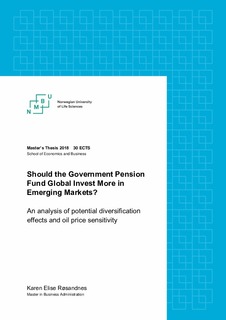| dc.contributor.advisor | Gjølberg, Ole | |
| dc.contributor.advisor | Henriksen, Tom Erik Sønsteng | |
| dc.contributor.author | Røsandnes, Karen Elise | |
| dc.coverage.spatial | Norway | nb_NO |
| dc.date.accessioned | 2018-10-22T11:18:02Z | |
| dc.date.available | 2018-10-22T11:18:02Z | |
| dc.date.issued | 2018 | |
| dc.identifier.uri | http://hdl.handle.net/11250/2568964 | |
| dc.description.abstract | This thesis examines the diversification effects from investing in 19 emerging markets for the period January 1998 to September 2017. How investments in these markets correspond to changes in oil prices are also investigated. The results indicate that emerging markets can give a diversification effect to the Fund. However, this requires exposure to high country-specific risk. The relationship between emerging markets and changes in oil prices is analyzed through a Distributed Lag Model. Most of the markets have a low sensitive to changes in the oil price, and this is perceived as beneficial for the Norwegian economy. This thesis conclude that emerging markets cannot be used to “hedge” against falling oil prices. | nb_NO |
| dc.language.iso | eng | nb_NO |
| dc.publisher | Norwegian University of Life Sciences, Ås | nb_NO |
| dc.rights | Attribution-NonCommercial-NoDerivatives 4.0 Internasjonal | * |
| dc.rights.uri | http://creativecommons.org/licenses/by-nc-nd/4.0/deed.no | * |
| dc.title | Should the government pension fund global invest more in emerging markets? : an analysis of potential diversification effects and oil price sensitivity | nb_NO |
| dc.type | Master thesis | nb_NO |
| dc.description.localcode | M-ØA | nb_NO |

